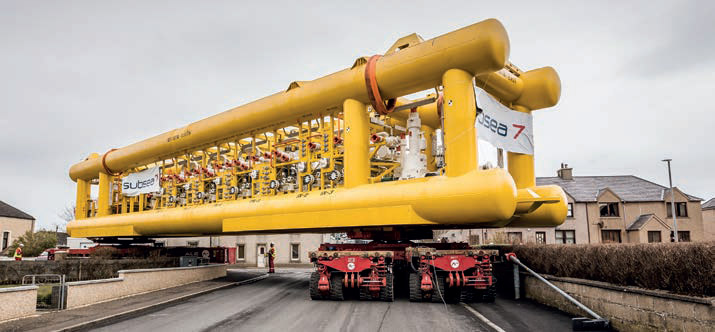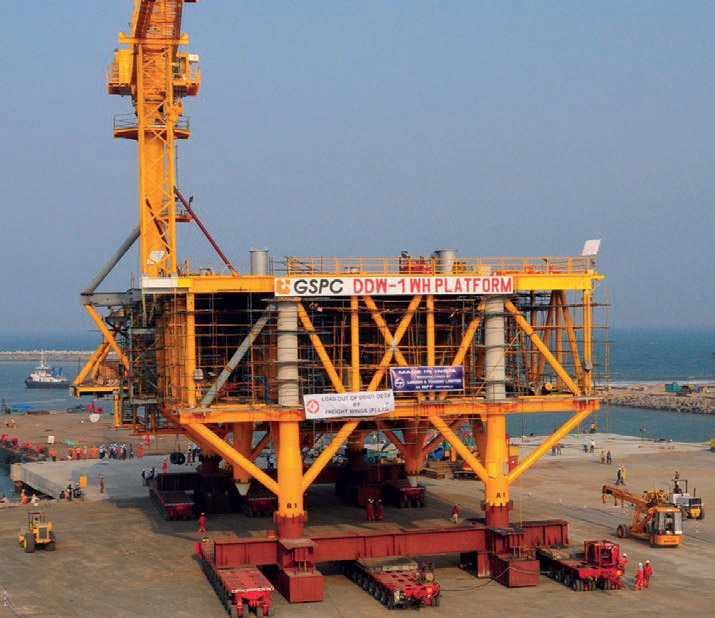Heading Offshore
10 June 2020The increased size of offshore oil and gas components has inevitably influenced the way they are being transported, Sotiris Kanaris reports.
For decades, major energy companies have invested heavily to boost the efficiency and capacity of their offshore oil and gas operations. In order to achieve that, some of the components used—such as modules, platforms, jackets—have increased in size, creating new requirements in terms of in-land transportation.
Sarens has been serving the oil and gas industry since the late seventies, when the offshore industry started to develop in Europe. Carl Sarens, director of global projects, engineering and technical solutions at Sarens, says: “The demands of the industry have been changing over the years primarily on two domains: operational excellence with focus on safety and quality; and the significant growth in the number and size of cargoes to be handled, mainly driven by modularisation.”
The transportation of the offshore oil and gas industry heavy structures is a complex process. The companies providing this service are working closely with Engineering Procurement Construction (EPC) companies, owners/operators and fabricators. Mammoet has been working closely with the industry since large-scale permanent oil platforms and jackets came onto the world stage in the 1970s.
Dan Kempin, business development manager, offshore services, at Mammoet, says they are involved as early as the design phase. “When jackets, modules and platforms are being designed, our engineers advise on their handling. Through an in-depth understanding of their structure, we can establish safer, smarter handling of the abnormal loads. By considering factors such as the centre of gravity, lifting points, yard space, ground bearing pressure and so on, we can ensure that any constraints are tackled head on, therefore avoiding impacts to planning schedules,” he says.
Kempin says that across the oil and gas sector, there is a very rigid set of criteria to which subcontractors need to adhere once customers identify their need. He describes the process: “Subcontractor pre-qualification, then the scope of work, technical approval, only then to proceed to the commercial phase. So naturally, we are involved from a very early stage in the process. It could be four years from an initial enquiry to execution.”
Apart from technical and operational reasons, there are commercial reasons behind the early involvement. “For offshore, cost-effectiveness is always important—this is the reason why offshore projects have grown exponentially in size, and for the adoption of modular construction techniques. It’s also the reason why our customers talk to us early on during each project, so that modifications can be incorporated in the design phase to streamline construction and reduce the amount of changes required in the field,” Kempin explains.
Sarens is also involved in early stages of projects, not only with its EPC clients, but also with the project owners as well as construction yards to support feasibility studies, develop transport schemes and for budgeting purposes. “These feasibility studies often have a much wider scope.
As well as defining the optimum transport configurations and related criteria, they define layout, storage areas, trailer path and timeline,” Carl Sarens says.
Over the years, Sarens has seen an increased demand for factory to foundation transportation. “Clients often approach us in an early phase, to assist with engineering for their logistics/transport challenge from building location to final project location. Our input with regards to transportability contributes to maximise off-site construction in order to limit site impact and project duration.”
On Wheels
Self-propelled and electronically steered modular trailers or self-propelled conventional modular steer trailers are often used to transport these components.
“In both types of trailers we have seen an evolution in axle line capacity together with more performance control/operating system to meet latest industry standards on emission and safety,” says Carl Sarens.
Member of the board at Goldhofer, Rainer Auerbacher has also identified an increased focus on safety. “Over the past 15 or so years, we have seen some changes with regards to the equipment requirements, which is partly due to an increased capacity within the industry. Previously the full transport concept was not so focused on safety margins and by means of pre-engineering. The method statements and safety margins have gained a lot of importance. This development has not only happened in the offshore oil and gas sector, it has also very much increased in the offshore wind business.”
Auerbacher summarises the needs of this market: higher capacity modules, stronger spine beams, raising capacity of trailers, less ground pressure due to the setup of the transport equipment. The Goldhofer products mainly used for the transportation of the big offshore oil and gas structures are the PST/SL, PST/SL-E and also PST/ES-E.
“Our flexibility in combination and synchronisation of different types and different setups make the planning and engineering of the big moves easier. This is a huge benefit of the flexibility of different setups (longitudinal and transversal combinations), split units and open configurations of one family of equipment. Those key factors come along with stronger spines and increased traction capacity to adjust the equipment to a higher payloads. This flexibility with strong performance and detailed and easy steering operation is appreciated by our customers,” says Auerbacher.
Cometto’s self-propelled electronically steered modular vehicles (MSPE) are also being used by for the transportation of heavy loads for the offshore oil and gas industry. The MSPE series comprises four products with capacities up to 70t: MSPE 40T, MSPE 48T, MSPE EVO2 60T, MSPE EV03 70T.
Giovanni Monti, head of sales at Cometto, says: “Thanks to their modularity, versatility and manoeuvring accuracy in the tightest of spaces as well as the extensive range of accessories, the self-propelled modular trailers from Cometto offer the ideal transport solution for every challenge in the heavy categories in sectors such as heavy duty transport, heavy industry, shipbuilding, oil and gas, offshore technology and others. Each series may consist of three, four, five or six axle lines. The power packs of the self-propelled modular trailers are available in various sizes, depending on the number of driven axles. Side-by-side coupling accessories enable the lateral grouping of several combinations.”
Routes
The routes that the trailers loaded with the offshore oil and gas components carry out vary.
The heavy and ultra-heavy modules are in most cases for greenfield projects, for which site specific roads or offloading facilities (MOF) are build. In brownfield projects transport over public roads or existing infrastructure is often needed.
“In case of transport over public road and/or existing infrastructure, an in depth study is required to check transport configuration and feasibility, as well as the impact of possible street furniture removal and road improvements (typically to allow making a turn),” says Carl Sarens.
He adds that transporting heavy loads on public roads is sometimes a challenge; having to obtain permits, remove street furniture, cut powerlines and develop a traffic management plan. “In some countries road regulations can differ from state to state and this can create a huge amount of administration and follow up.
“Also—and more specific to the offshore related projects—load-in and load-out operations are very complex and many parties are involved. The more parties involved, the more potential risks if milestones and scope are not clearly split and defined. Detailed and well in advance set planning is crucial.”
Sarens recently worked with BOMESC Offshore Engineering to load out and transport a series of irregular modules on site at Tianjin, China.
Sarens’ role was to load out 17 floating production storage and offloading (FPSO) modules weighing a combined total of 26.341t, with the heaviest module weighing 2.720t. The operation was carried out on behalf of project owner MODEC, a global supplier and operator of offshore platforms.
Sarens selected SPMTs for the project because their high capacity and high manoeuvrability make them the perfect type of equipment to move these ultra heavy loads.
The 104-axle lines SPMTs and four Power Pack Units (PPUs) were transported to the site via 20 trucks. Rigging took two days, and the crew worked in a confined space and along a very tight route with a minimum clearance of just 100mm. Successful transport and assembly were possible partly because Sarens had carried out a road survey in advance, accounting for obstacles along the route to save on time and work required.
Sarens also conducted detailed equipment inspections before the operation began. Because the modules to be loaded out had a centre of gravity that was offset to one side, the crew took advantage of the SPMTs’ capacity and made specific trailer arrangements to meet module load out requirements.
“The load-out was carried out safely and efficiently,” said project manager Martin Huang. “Good planning and teamwork were the key to this project.”
The importance of good planning was also shown at Mammoet’s recent CNOOC BPII project, which involved an extremely challenging over-the-road transportation for Subsea7 in Scotland.
Subsea7 manufactures pipeline bundles for the North Sea market from a location just outside Wick, Scotland. Large manifold structures called towheads sit at each end of these bundles once installed, and these are manufactured off-site.
So, they must be loaded-in at Wick and transported through the narrow streets of the town in a highly intricate process taking months of preparation. At 37m x 6m x 5.5m, these were substantial structures, and manoeuvring them with SPMTs through an at times 18% gradient and with only centimetres of clearance at time was a challenging task.
Another offshore oil and gas related project Mammoet was involved in was the Gudrun Oil and Gas Field project, where Statoil built a 12,000t deck to operate the field. Building the entire platform in the volatile Norwegian weather conditions at high labour cost was not an option. Therefore, it was decided to build half the deck in Norway and the other half in Thailand. Mammoet used 234 SPMT axle lines for the load-out of the 6,000t module in Thailand.
Skids and Strands Jacks
The transportation of these components does not always involve SPMTs, sometimes other methods such as skidding have to be used. Kempin says: “This most visible element of our work can involve a shore pull or skidding load-out of topsides or jackets with five-figure tonnage. Typically, large skidding, ballasting and mooring systems are used during these projects.”
An example of this work is an 18,000t topside load-out and float-over transport by ALE (now acquired by Mammoet) from a yard in Zhuhai, China. ALE’s hydraulic skidding equipment was installed underneath the topside, with the skid tracks installed on a foundation of concrete blocks, before the skid shoes were positioned. This was followed by the installation of the strand jacks.
A strand jack skidded load-out was performed to move the topside onto a heavy lift barge. ALE performed the barge ballasting.
The external ballast pumps were synchronised with the internal ones. The fully-integrated system saved installation time after the load-out as it could also be used for the floatover. During the operation, ALE used four 850t strand jacks, four 2,400t ballast pumps, and 12 1,000t de-ballast pumps.
ALE recently also carried out the load-out of Vietnam’s largest offshore jacket. The Sao Vang and Dai Nguyet gas and condensate development is located approximately 300km south-east of Ho Chi Minh City, Vietnam. Phase one of the development includes the installation of a new central processing platform (CPP).
First, the CPP needed to be supported by a jacket weighing 12,733t. The size of the jacket, with dimensions of 131m x 81.7m x 56m, led to ALE determining a strand jack load-out to be both the most feasible and cost-effective solution.
The jacket was to be loaded-out onto a barge from VietsovPetro shipyard in Vung Tau and then towed to the launch location. Extensive engineering preparations took place, which had to consider the vast size of the jacket. It was too large to be lifted by a crane and its structural design meant an SPMT load-out was not practical either.
The jacket was built on skid beams and a launch truss, with breakout jacks used to move the jacket from its initial position before strand jacks and winches began the pulling operation. The barge was equipped with high capacity submersible external ballast pumps, which were synchronised with the barge’s internal ones. The internal ballast system was then used for deballasting with ALE monitoring and controlling the ballasting from the bridge. The overall load-out operation utilised three 600t capacity breakout jacks, four 850t capacity strand jacks, ten winches of 20t and 40t capacity, as well as an integrated ballast system with two 2,400t capacity pumps and 15 1,000t capacity pumps.
Sarens has recently performed a load out (skidding, ballasting, and barge monitoring during the operation) of 12,060t Pegaga CPP jackets for Sapura Fabrication in Malaysia.
Sarens decided to deploy 600t digicells with 800t weighing jacks, 4 x 588t strandjacks, 20 submersible pumps, a barge monitoring system, and six 50t winches. The jacket measuring 190m in length and 77m in width and weighing 12,060t was safely skidded to final position in about seven hours.
COVID-19 Effect
Covid-19 has caused a severe damage to the oil and gas industry, as the fall in demand for energy has caused prices to drop. This has been reflected in major energy companies’ financial results for the first quarter of the year.
Prior to its acquisition by Mammoet, a team at ALE has analysed the offshore energy market—greenfield, brownfield and decommissioning.
Kempin talks about the findings and expectations: “Prior to Covid-19, the research showed that greenfield developments in oil and gas and renewables would be relatively steady over the next seven years. Operational maintenance projects have been on the increase since the market last reached $30 per barrel four years ago, giving a positive outlook. Then there was decommissioning of which a large proportion takes place on our doorstep in the North Sea.
“We expect decommissioning to increase over the next five years on the back of the low oil prices. In fact, circa one million tonnes of infrastructure is to be decommissioned and a steady workload of 12 topsides are to be decommissioned per year in the UKCS up to 2025. Offshore is an industry in near-constant cyclical change within these three development types.”
Kempin says the recent pandemic—and of course oil prices—will influence the market, pushing investment decisions further into the future, “but offshore services operates very much on a long-term view.”
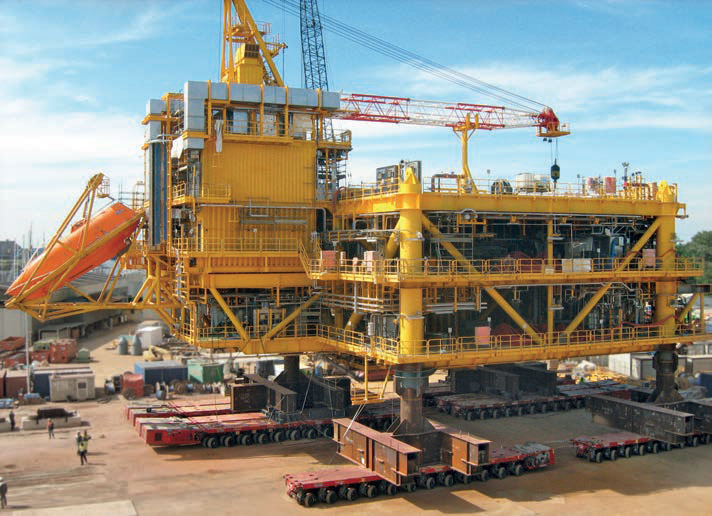 A complete offshore platform of more than 3,500t moved by Fagioli with a open-compound combination of Cometto MSPE 40T and MSPE EVO2 (total = 120 axles).
A complete offshore platform of more than 3,500t moved by Fagioli with a open-compound combination of Cometto MSPE 40T and MSPE EVO2 (total = 120 axles).
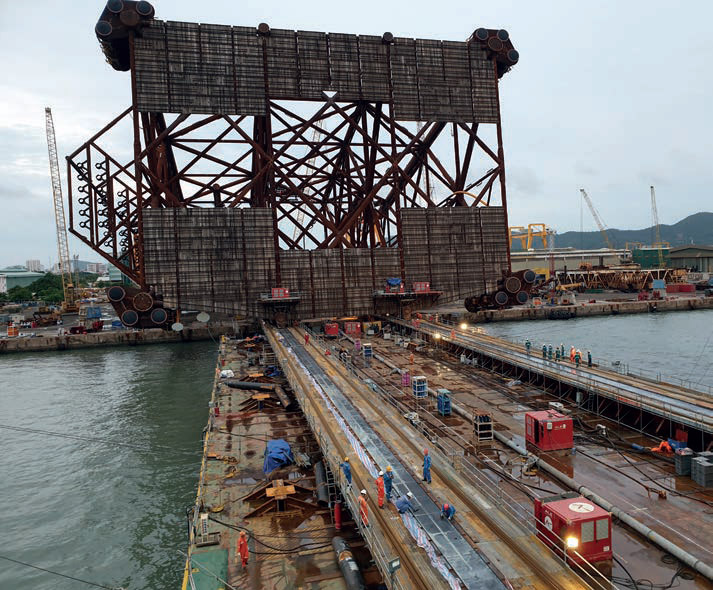 ALE, now part of Mammoet, carried out the load-out of Vietnam’s largest offshore jacket, weighing 12,733t. The size of the jacket, with dimensions of 131m x 81.7m x 56m, led to ALE determining a strand jack loadout to be both the most feasible and cost-effective solution.
ALE, now part of Mammoet, carried out the load-out of Vietnam’s largest offshore jacket, weighing 12,733t. The size of the jacket, with dimensions of 131m x 81.7m x 56m, led to ALE determining a strand jack loadout to be both the most feasible and cost-effective solution.
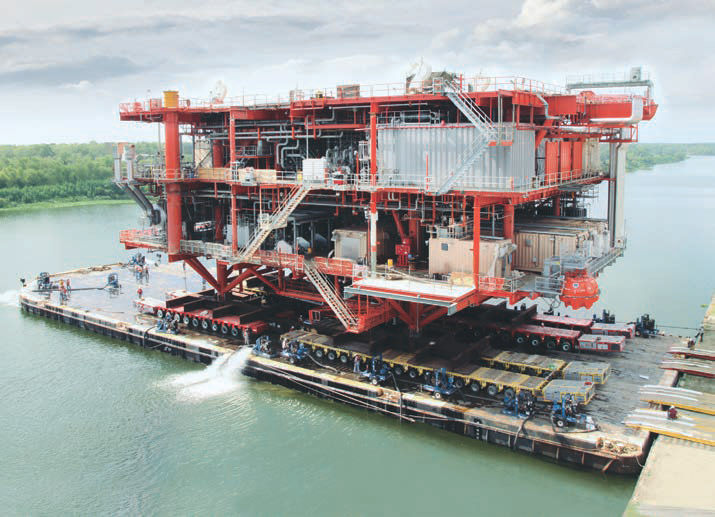 Transport of an offshore module weighing more than 1,000t using eight different Goldhofer selfpropelled units.
Transport of an offshore module weighing more than 1,000t using eight different Goldhofer selfpropelled units.
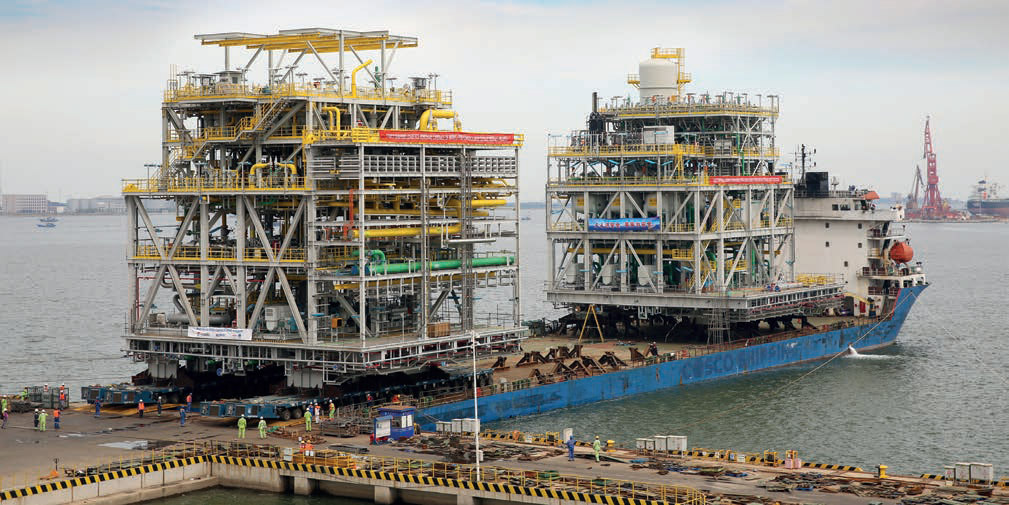 Sarens recently worked with BOMESC Offshore Engineering to load out and transport a series of irregular modules on site at Tianjin, China. Sarens’ role was to load out 17 floating production storage and offloading (FPSO) modules weighing a combined total of 26.341t, with the heaviest module weighing 2.720t.
Sarens recently worked with BOMESC Offshore Engineering to load out and transport a series of irregular modules on site at Tianjin, China. Sarens’ role was to load out 17 floating production storage and offloading (FPSO) modules weighing a combined total of 26.341t, with the heaviest module weighing 2.720t.
